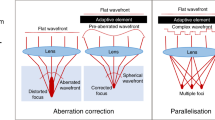Abstract
Complex design processes require a high level of expertise and are time consuming. By assisting the engineer with a computer aided design system the design process can be accelerated and be made more reliable. Actuator system design for laser micro adjustment is complex and its challenges may be a hindrance for the application of laser micro adjustment. To overcome this obstacle a computer aided design system was developed which utilizes a multi-objective optimization algorithm to automatically improve actuator design. In this paper, the system and its components are presented. A special focus will be upon the assessment functions which allow the efficient assessment of an actuator design. An application example will be given to demonstrate the functionality of the design system.






Similar content being viewed by others
References
Eschenauer H, Koski J, Osyczka A (1990) Multicriteria design optimization—procedures and applications. Springer, Heidelberg
Coello Coello CA, Lamont GB, Van Veldhuizen DA (2007) Evolutionary algorithms for solving multi-objective problems. Springer, Heidelberg
Deb K (2004) Multi-objective optimization using evolutionary algorithms. Wiley, London
Campbell MI, Cagan J, Kotovsky K (1999) A-design: an agent-based approach to conceptual design in a dynamic environment. Res Eng Des 11:172–192. doi:10.1007/s001630050013
Olowinsky A (2003) Laserstrahlmikroumformen—neues Justageverfahren in der Mikrotechnik. Shaker, Germany
Huber A (2001) Justieren vormontierter Systeme mit dem Nd:YAG-Laser unter Einsatz von Aktoren. Meisenbach, Germany
Müller B (2001) Laser adjustment—models for the design of actuators. In: Geiger M, Vollertsen F (eds) Laser assisted net shape engineering, vol 3. Meisenbach, Germany, pp 519–526
Vollertsen F (1996) Laserstrahlumformen, lasergestützte Formgebung: Verfahren, Mechanismen. Modulierung, Meisenbach, Germany
Bechtold P, Schmidt M (2007) Non-thermal micro adjustment using ultrashort laser pulses. In: JLPS—Japan Laser Processing Society (eds) Proceedings of LPM—the 8th international symposium on laser precision microfabrication, pp 1–5
Hagenah H, Wurm T (2005) Problem specific design of actuators for micro adjustment. Advanced Mater Res 6-8(8):271–278
Goldberg DE (1989) Genetic algorithms in search optimization and machine learning. Addison-Wesley, Reading
Pfeiffer F, Reithmeier E (1987) Roboterdynamik. Teubner, Berlin
Gagné C, Parizeau M, Dubreuil M (2003) Distributed beagle: an environment for parallel and distributed evolutionary algorithms. In: Proceedings of the 17th annual international symposium on high performance computing systems and applications (HPCS), pp 201–208
Report on the Brite-EuRam Projekt AMULET (Accurate Manipulation Using Laser Technology; Project-Nr. BE95-1230)
Otto A (2005) Fundamentals of laser beam adjusting of micro systems. In: Vollerstsen F, Seefeld T (eds) Thermal froming, proceedings of the IWOTE’05, Strahltechnik Band 26. BIAS Verlag, Bremen, pp 83–92
Plettke R, Hagenah H, Geiger M (2007) Computer assisted design of actuator systems for laser micro adjustment. Key Eng Mater 344:807–814
Plettke R, Hagenah H, Geiger M (2007) Computer assisted design of complex actuator systems for laser micro adjustment. In: Geiger M, Otto A, Schmidt M (eds) Proceedings of the LANE. Meisenbach, Germany, pp 533–544
Hagenah H, Plettke R, Klämpfl F (2008) Fast problem specific approaches for the evaluation of laser beam propagation in process planning. In: Teti R (ed) Proceedings of the 6th CIRP international conference on intelligent computation in manufacturing engineering (in press)
Nearchou AC (1998) Solving the inverse kinematics problem of redundant robots operating in complex environments via a modified genetic algorithm. Mech Mach Theory 3:273–292
Author information
Authors and Affiliations
Corresponding author
Additional information
The presented work was carried out within the research project 530/59-2 entitled “Algorithmen und Bewertungsmethoden zur Optimierung von Aktorsystemen für die Mikrosystemtechnik” funded by the German Research Foundation (DFG). The authors would also like to thank the Erlangen Graduate School in Advanced Optical Technologies (SAOT) for their support.
Rights and permissions
About this article
Cite this article
Geiger, M., Plettke, R. & Hagenah, H. Multi-objective optimization of actuator system design for laser micro adjustment. Prod. Eng. Res. Devel. 3, 181–188 (2009). https://doi.org/10.1007/s11740-008-0147-8
Received:
Accepted:
Published:
Issue Date:
DOI: https://doi.org/10.1007/s11740-008-0147-8




